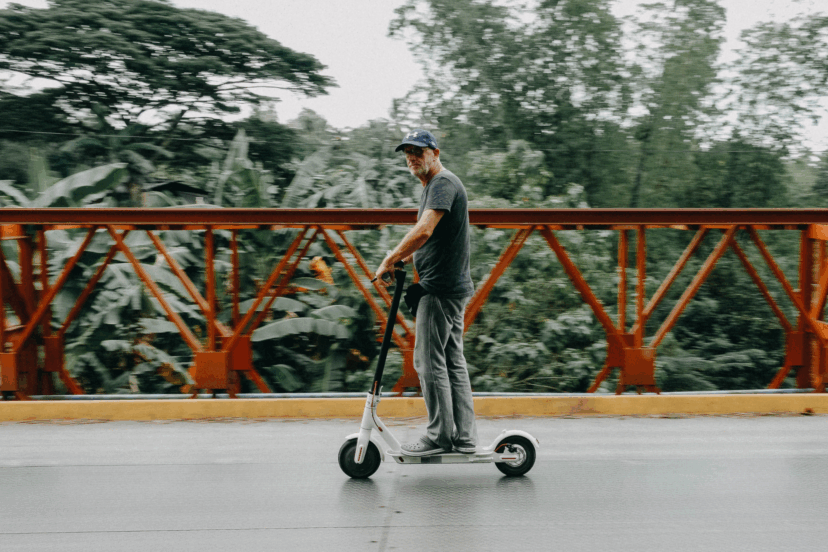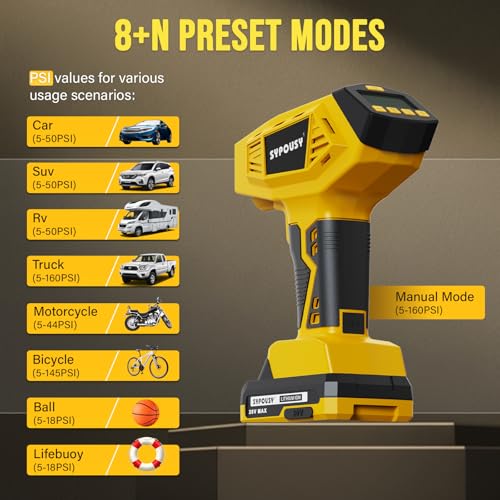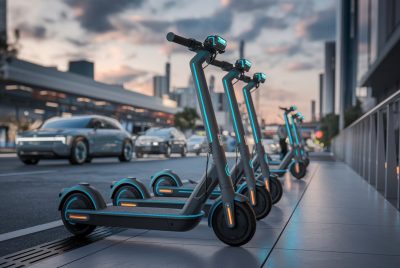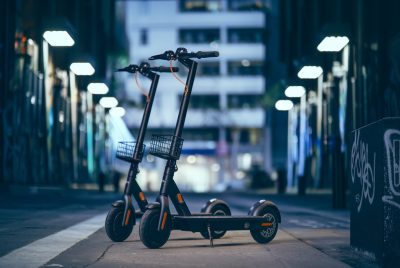How to Increase Electric Scooter Range
*We may earn a commission for purchases made using our links. Please see our disclosure to learn more.
The battery indicator drops to 20% when you’re still miles from home. Your heart sinks as you realize you might need to walk the rest of the way, pushing your electric scooter alongside you. Sound familiar? Range anxiety is one of the most common frustrations among electric scooter riders, turning what should be a convenient, enjoyable ride into a stressful calculation of distance versus battery life.
Whether you’re commuting to work, running errands, or exploring your neighborhood, getting the most out of your electric scooter’s battery isn’t just about convenience—it’s about freedom. The difference between a scooter that barely gets you through your daily route and one that handles everything you throw at it often comes down to how you ride and maintain it.
The good news? You don’t need a new battery or expensive upgrades to significantly improve your range. Small changes in riding habits, regular maintenance, and smart planning can add miles to every charge. This guide shares ten practical, proven strategies that riders have used to extend their scooter’s range, helping you ride farther with confidence.
“The single most impactful change riders can make is understanding that range isn’t fixed—it’s a variable they control through their choices every time they ride.”
— Electric Vehicle Research Institute
Key Takeaways
- Tire pressure matters more than you think: Properly inflated tires can improve range by up to 10-15% by reducing rolling resistance
- Weight management is crucial: Every extra pound decreases efficiency; removing unnecessary accessories and cargo extends battery life
- Riding style dramatically affects range: Smooth acceleration, maintaining steady speeds, and minimizing stops preserve significantly more battery than aggressive riding
- Temperature impacts performance: Cold weather can reduce range by 20-30%; keeping batteries warm and storing scooters properly helps maintain capacity
- Regular maintenance pays off: Clean components, lubricated parts, and properly adjusted brakes ensure your scooter runs at peak efficiency
Recommended Products for Extended Range
Before diving into the tips, here are four essential products that can help maximize your electric scooter’s performance:
Digital Tire Pressure Gauge
The AstroAI Digital Tire Pressure Gauge with Inflator is a heavy-duty, precision-calibrated tool designed to help riders increase electric scooter range by maintaining optimal tire pressure. Featuring an ultra-accurate 0.1-resolution digital display and compatibility with both ¼” and ½” NPT air compressor outputs, this inflator ensures fast, reliable, and consistent measurements from 3–250 PSI. Built with stainless steel, high-quality brass, and durable ABS, it provides long-lasting performance for scooters, bikes, cars, and more.
If you’re looking for a simple, reliable way to increase electric scooter range, maintaining proper tire pressure is one of the easiest and most effective methods—and the AstroAI Digital Tire Pressure Gauge with Inflator makes that task effortless. Underinflated tires create extra rolling resistance, draining battery power faster and reducing range by several miles per charge. With the AstroAI gauge’s 0.1-resolution digital accuracy, you can ensure your scooter tires are always inflated to the manufacturer’s recommended PSI.
- Accuracy: Delivers ultra-precise readings within 1% to keep tires properly inflated.
- Durability: Heavy-duty stainless steel and brass build for long-lasting reliability.
- All-in-One Design: Includes inflator, gauge, chuck, hose, bleed valve, and valve tools.
- Requires Compressor: Needs an external air compressor to use the inflation feature.
- Bulky for Pockets: Not as compact as simple stick or pen-style tire gauges.
- Learning Curve: Multiple features may take beginners a few uses to master.
Portable Electric Air Pump
The Sypousy Upgraded Tire Inflator Portable Air Compressor is a powerful 160 PSI cordless pump engineered for riders who want to increase electric scooter range through proper tire maintenance. With 2× faster inflation, a 20V 4.0Ah rechargeable battery, and dual power options (battery or 12V DC), this inflator delivers dependable performance at home or on the go.
For riders looking to increase electric scooter range, tire pressure plays a major role in performance. Underinflated tires create more friction, causing the battery to drain faster and reducing range by several miles. The Sypousy 160 PSI Portable Air Compressor solves this problem with fast, accurate inflation and a convenient cordless design.
- Power Flexibility: Dual-power design (20V battery + 12V corded) ensures constant availability.
- Fast Performance: Metal cylinder delivers 2× faster inflating with automatic shut-off.
- Versatile Use: Works with cars, scooters, e-bikes, bikes, balls, and Makita batteries.
- Higher Price Point: Costs more than standard portable inflators.
- Battery Weight: 20V battery adds weight for handheld use.
- Noise Level: 65 dB is quieter than most pumps but still noticeable in enclosed spaces.
Waterproof Scooter Cover
The MD34 Electric Scooter Cover is a premium, all-season protective solution designed to keep your scooter in peak condition and help increase electric scooter range by preventing environmental damage that affects battery efficiency. Measuring 47" × 24" × 45", this precision-fit cover is compatible with most 300W–800W scooters, including popular brands like Segway, iScooter, Gotrax, and Inmotion.
Protecting your electric scooter isn’t just about keeping it clean—it’s also a smart way to increase electric scooter range. Exposure to rain, dust, UV rays, and fluctuating temperatures can degrade battery performance over time, causing reduced efficiency and shorter rides. The MD34 Outdoor Waterproof Electric Scooter Cover prevents these issues by providing full-coverage defense for daily storage or long-term parking.
- Strong Protection: Heavy-duty 600D Oxford fabric blocks water, UV, dust, and scratches.
- Windproof Build: Dual buckles + double drawstring prevent the cover from blowing off.
- Universal Fit: Compatible with most mainstream electric scooters (47" size).
- Bulky Storage: Thick 600D fabric takes up more space compared to thin covers.
- No Lock Hole: Lacks a built-in security lock opening for chained parking.
- Limited Color Choices: Only available in two color options.
Battery Insulation Wrap
The BiKase Neoprene E-Bike Battery Cover is a high-performance, insulating sleeve engineered to safeguard your electric bike or scooter battery and help increase electric scooter range—especially in cold or wet conditions. Built from premium neoprene, this cover prevents power loss caused by low temperatures by keeping the battery insulated and maintaining optimal operating warmth.
Cold weather is one of the biggest enemies of battery efficiency—and one of the most overlooked ways riders can increase electric scooter range. As temperatures drop, battery cells become less efficient, causing shorter rides and reduced output. The BiKase Neoprene E-Bike Battery Cover solves this issue by providing a thick insulating layer that helps your battery retain heat, maintain consistent voltage, and deliver better range in cooler environments.
- Cold-Weather Efficiency: Neoprene insulation helps preserve battery warmth and power output.
- Element Protection: Guards against water, dirt, and scratches during rides or transport.
- Convenient Storage: Includes an extra pocket for small items while riding.
- Not Fully Waterproof: Water resistant, but not intended for full submersion.
- Fit Specificity: Must purchase correct size (medium or large) for proper snug fit.
- Limited Color Options: Available only in black.
Understanding What Drains Your Battery
Before implementing range-extending strategies, it helps to understand what actually consumes your scooter’s battery power. The motor draws energy based on the work it performs, and that work increases with speed, acceleration, rider weight, terrain incline, and mechanical resistance. Wind resistance grows exponentially with speed, meaning riding at 20 mph requires substantially more power than cruising at 15 mph.
External factors play an equally important role. Temperature affects battery chemistry directly—lithium-ion batteries deliver less capacity in cold conditions because chemical reactions slow down. Conversely, excessive heat can degrade battery cells over time. Terrain dramatically impacts consumption too; climbing hills can drain batteries three to four times faster than riding on flat ground.
Understanding these fundamentals helps explain why the same scooter might achieve 25 miles on one ride and barely 15 on another. Range isn’t just about battery capacity—it’s about how efficiently you use that capacity.
1. Master Tire Pressure Optimization
Tire pressure represents one of the most overlooked yet impactful factors affecting electric scooter range. Under-inflated tires create excessive rolling resistance, forcing your motor to work harder and drain battery faster. Over-inflated tires reduce contact patch and grip but can actually improve efficiency on smooth surfaces.
Check your tire pressure weekly using a reliable gauge. Most electric scooters perform best at pressures between 40-50 PSI for pneumatic tires, but always consult your manufacturer’s specifications. The difference between properly inflated tires and under-inflated ones can mean 2-4 extra miles per charge.
Temperature affects tire pressure significantly—tires lose approximately 1 PSI for every 10-degree drop in ambient temperature. During seasonal changes, monitor pressure more frequently and adjust accordingly. Cold morning commutes might require slightly higher inflation than afternoon rides.
Consider your riding surface when optimizing pressure. Smooth pavement allows for higher pressures and maximum efficiency, while rougher surfaces benefit from slightly lower pressure for better shock absorption and control. Finding your optimal pressure involves some experimentation based on your typical routes and riding style.
2. Optimize Your Riding Speed
Speed is a major battery consumer, and the relationship isn’t linear—it’s exponential. Riding at maximum speed drains batteries disproportionately fast compared to moderate speeds. Most electric scooters achieve optimal efficiency between 50-70% of their top speed, where motor efficiency peaks and wind resistance remains manageable.
Resisting the temptation to ride at full throttle everywhere can extend range by 20-30%. If your scooter tops out at 25 mph, cruising at 15-18 mph balances reasonable speed with excellent range. You’ll arrive at your destination only slightly later but with substantially more battery remaining.
Use different speed modes strategically. Eco mode isn’t just for emergencies—it’s an efficient way to maximize range when you’re not in a hurry. Save sport or turbo modes for situations requiring extra power, like steep hills or when you’re running late and have charging access at your destination.
Pay attention to how your scooter feels at different speeds. There’s often a “sweet spot” where the motor seems to run smoothly and efficiently without straining. This speed typically aligns with the motor’s peak efficiency range and delivers the best balance of speed and battery conservation.
3. Perfect Your Acceleration Technique
How you accelerate matters as much as your cruising speed. Hard acceleration from stops forces the motor to draw maximum current, creating significant battery drain. Smooth, gradual acceleration allows the motor to work more efficiently and conserves substantial energy over the course of a ride.
Think of throttle control as a skill worth developing. Instead of twisting to full power immediately, gradually increase throttle over 3-5 seconds when starting from a stop. This technique not only saves battery but also improves ride smoothness and reduces wear on drivetrain components.
Anticipate stops and plan ahead. When you see a red light or stop sign ahead, begin coasting early rather than maintaining speed until the last moment. Every time you brake, you’re converting kinetic energy into waste heat instead of preserving it. Reducing unnecessary braking directly translates to better range.
In stop-and-go traffic or urban environments, acceleration patterns become even more critical. The constant starting and stopping in city riding is why urban range often falls 30-40% below highway or suburban riding. Being conscious of how aggressively you accelerate after each stop makes a measurable difference in these scenarios.
4. Reduce Weight and Minimize Cargo
Every pound your scooter carries requires energy to move and accelerate. While you can’t change your body weight easily, you can eliminate unnecessary cargo and accessories that add weight without providing essential value. That heavy backpack, unnecessary toolkit, or decorative accessories all reduce your potential range.
Evaluate what you actually need to carry. Many riders accumulate items on their scooters over time—extra locks, maintenance tools, accessories—that rarely get used but constantly drain battery. A comprehensive weight audit might reveal 5-10 pounds of non-essential items that could be removed or left at home on most rides.
Consider lighter alternatives for items you must carry. A lighter lock, smaller toolkit, or streamlined bag can maintain functionality while reducing weight. Even small reductions add up when you’re trying to maximize efficiency and extend range.
Distribute weight properly when you do carry cargo. Weight positioned low and centered affects handling less and creates slightly better efficiency than cargo mounted high on handlebars or far behind the rider. While the difference is modest, proper weight distribution improves both range and ride quality.
5. Maintain Optimal Battery Health
Battery health determines available capacity, and degraded batteries simply can’t deliver the range they once did. Proper charging habits significantly impact long-term battery health and maintain range over your scooter’s lifetime. Lithium-ion batteries prefer partial charge cycles over complete drain-and-charge cycles.
Avoid routinely charging to 100% or discharging to 0% unless necessary. Keeping battery levels between 20-80% for daily use reduces stress on cells and extends battery lifespan. Charge to full only when you know you’ll need maximum range for a longer ride.
Store your scooter with approximately 50-60% charge if you won’t be riding for extended periods. Storing batteries at very high or very low states of charge accelerates degradation. Monthly maintenance charges during storage periods help maintain cell balance and prevent deep discharge damage.
Temperature management during charging matters too. Avoid charging in extreme temperatures—both hot and cold conditions stress batteries during the charging process. If your scooter was in cold conditions, let it warm to room temperature before charging. Similarly, don’t charge immediately after a ride when batteries are heat-soaked; let them cool for 15-30 minutes first.
6. Minimize Brake Drag and Mechanical Resistance
Mechanical resistance from dragging brakes, misaligned wheels, or friction in the drivetrain forces your motor to work harder than necessary. Regular inspection and adjustment of these components ensures your scooter rolls freely and efficiently.
Check that wheels spin freely when lifted off the ground. They should rotate smoothly without wobbling or making noise. Any grinding, clicking, or rubbing sounds indicate issues requiring attention. Bearings should be clean and properly lubricated—degraded bearings create significant rolling resistance.
Brake systems require regular adjustment to prevent drag. Disc brakes should engage only when activated, not rub constantly against rotors. Even slight brake pad contact creates heat and resistance that drains batteries. Adjust calipers so pads clear rotors by a small but consistent gap.
Lubricate moving parts according to your maintenance schedule. Chain drives need regular cleaning and lubrication to minimize friction. Folding mechanisms, suspension pivots, and steering bearings all benefit from appropriate lubrication that reduces mechanical resistance and improves efficiency.
7. Choose Routes Strategically
Route selection dramatically affects range consumption. Flat routes with minimal stops consume far less battery than hilly routes with frequent intersections. When planning trips, consider elevation changes and stop frequency as seriously as total distance.
GPS apps and mapping tools can show elevation profiles for routes. A longer route with minimal elevation gain might actually consume less battery than a shorter route with significant hills. When you have route options, choosing the flatter path often delivers better overall efficiency.
Minimize stop frequency when possible. Routes with timed lights or roundabouts that maintain traffic flow preserve more battery than routes with numerous stop signs requiring full stops and re-acceleration. The energy saved by maintaining momentum adds up significantly over longer rides.
Surface quality matters more than many riders realize. Smooth pavement requires less energy than rough, cracked, or unpaved surfaces. The constant vibration and small bumps on poor surfaces force the motor to work harder maintaining speed. When route options exist, prioritize smoother roads even if they’re slightly longer.
8. Adapt to Weather Conditions
Weather significantly impacts electric scooter range, with cold temperatures being the primary culprit. Battery capacity drops measurably in cold weather—losing 20-30% of normal range isn’t unusual when temperatures fall below freezing. Understanding and adapting to weather conditions helps maintain the best possible range year-round.
Keep batteries warm in cold weather. Store your scooter indoors when possible, and if you must leave it outside, bring the battery inside if it’s removable. Starting a ride with a warm battery preserves significantly more capacity than riding with a cold battery.
Wind direction and speed affect range more than most riders expect. Strong headwinds can reduce range by 15-20% by increasing the work required to maintain speed. When possible, plan routes that minimize direct headwind exposure, or reduce speed slightly when riding into strong winds to maintain efficiency.
Rain and wet conditions increase rolling resistance and reduce efficiency slightly. Water on roads creates drag, and wet brakes may rub more than dry ones. While you shouldn’t avoid riding in rain, understand that range will be somewhat reduced and plan accordingly with buffer in your battery level.
9. Leverage Regenerative Braking Wisely
Many electric scooters feature regenerative braking, which recovers some energy during deceleration. While it won’t dramatically extend range, proper use of regenerative braking adds a few percentage points of efficiency and reduces wear on mechanical brakes.
Understand your regenerative braking system’s characteristics. Some systems activate progressively when you release throttle, while others require specific brake lever activation. Learning how your system responds helps you use it effectively without sacrificing safety or control.
Use regenerative braking for gradual speed reduction rather than emergency stops. It’s most effective for gentle, planned deceleration—like approaching a stoplight you see well in advance. Hard braking requires mechanical brakes and doesn’t allow regenerative systems time to recover meaningful energy.
Don’t over-rely on regenerative braking’s range-extending benefits. While helpful, it typically recovers only 5-10% of energy used for acceleration. The real benefit comes from the mindset it encourages—planning ahead, braking smoothly, and minimizing speed fluctuations that waste energy in the first place.
10. Perform Regular Maintenance
Consistent maintenance keeps all systems operating efficiently and prevents the gradual degradation that slowly reduces range over time. A well-maintained scooter simply performs better and delivers more miles per charge than a neglected one.
Create a maintenance schedule based on your riding frequency. Weekly checks should include tire pressure, brake function, and visible component condition. Monthly maintenance might involve deeper cleaning, lubrication, and detailed inspection of wear items. Annual professional servicing ensures components you can’t easily check yourself remain in good condition.
Keep your scooter clean. Dirt, dust, and grime increase friction and resistance throughout the drivetrain and moving parts. Regular cleaning isn’t just about aesthetics—it’s about maintaining efficiency. Pay special attention to the chain or belt drive, wheel bearings, and brake systems.
Address small issues promptly before they become major problems. A slightly loose component, minor brake rub, or small bearing noise might seem insignificant, but these issues compound over time. Fixing them immediately prevents efficiency loss and more expensive repairs later.
The Psychology of Range Management
Beyond technical factors, psychology plays an important role in maximizing range. Range anxiety often leads to inefficient riding behaviors—constantly checking battery levels, accelerating hard to “make up time,” or taking unnecessarily direct routes without considering efficiency.
Trust your scooter’s range after you’ve established patterns through experience. Learn what range you can expect under different conditions, then ride confidently within those parameters. Constant worry about battery level actually encourages the checking behavior that distracts from efficient riding techniques.
Plan buffer into your trips. Arriving with 20-30% battery remaining reduces stress and allows natural, efficient riding without constant monitoring. This buffer also accounts for unexpected detours, wind changes, or the gradual battery degradation that occurs over a scooter’s lifetime.
Living With Extended Range
Implementing these strategies transforms how you experience electric scooter riding. The difference between constantly worrying about battery and confidently handling your daily routes changes the entire relationship with your scooter. Range becomes less of a limitation and more of a known variable you manage effectively.
Some strategies become automatic with practice. Smooth acceleration and strategic braking eventually feel natural rather than conscious efforts. Checking tire pressure becomes routine maintenance rather than an extra chore. The cumulative effect of these habits adds significant range without requiring constant attention.
The real benefit extends beyond just extra miles. Efficient riding techniques reduce wear on components, create smoother rides, and often improve safety by encouraging anticipation and planning. Battery health maintained through proper charging habits means your scooter retains capacity longer, delaying expensive replacement needs.
Measuring Your Improvements
Track your range over time to understand what strategies work best for your riding style and conditions. Many scooters feature trip computers or apps that record distance and efficiency metrics. Reviewing this data helps identify which changes provide the most significant improvements.
Establish baseline measurements before implementing changes. Note your typical range under normal riding conditions, then measure again after consistently applying new techniques for a week or two. Real-world data from your actual riding provides better guidance than theoretical calculations.
Don’t expect dramatic overnight changes. Range improvement comes from cumulative small gains across multiple factors. A 5% improvement here, 8% there, and 3% from another technique combine to meaningful total range extension—potentially 15-25% better than before.
Conclusion
Extending your electric scooter’s range isn’t about expensive upgrades or battery replacements—it’s about understanding what drains battery and making smart choices to minimize waste. From maintaining proper tire pressure to perfecting your acceleration technique, each strategy contributes to better efficiency and more miles per charge.
The journey toward maximized range teaches patience and mindfulness. It encourages you to ride more smoothly, plan more thoughtfully, and maintain your scooter more consistently. These habits don’t just extend range—they improve your entire riding experience, reduce wear on components, and help your scooter last longer.
Start by implementing one or two strategies that seem easiest or most impactful for your situation. As these become habits, add more techniques until efficient riding becomes second nature. The extra miles you’ll gain make every ride more enjoyable and expand where your scooter can take you, transforming it from a limited-range vehicle into a truly practical transportation solution.
Frequently Asked Questions
How much can I realistically improve my electric scooter’s range?
Most riders can improve range by 15-25% through combined strategies like proper tire pressure, smooth riding techniques, weight reduction, and regular maintenance. Individual results vary based on current riding habits—riders with aggressive styles see larger improvements, while already-efficient riders gain smaller percentages.
Does riding in eco mode really make a significant difference?
Yes, eco mode typically extends range by 20-35% compared to sport mode by limiting top speed and reducing motor power output. The trade-off is slower acceleration and reduced top speed, but for commutes where maximum speed isn’t necessary, eco mode substantially extends how far you can ride on a single charge.
How often should I check my tire pressure?
Check tire pressure weekly, especially during temperature changes. Seasonal transitions require more frequent monitoring since tires lose approximately 1 PSI for every 10-degree temperature drop. Proper inflation is one of the easiest ways to maintain optimal range and only takes a minute to verify.
Can cold weather permanently damage my battery?
Cold weather temporarily reduces capacity but doesn’t cause permanent damage unless batteries are charged while extremely cold or stored in freezing conditions for extended periods. Bringing your scooter indoors or storing the battery at room temperature prevents cold-related issues and maintains long-term battery health.
Is it worth upgrading to a larger battery for more range?
Upgrading batteries can be expensive and isn’t always compatible with all scooter models. Before investing in a larger battery, implement the free or low-cost strategies in this guide—you might find you don’t need the upgrade. If you do upgrade, combine it with efficient riding techniques to maximize your investment and achieve the best possible range.














